The ASRock Z170 Extreme7+ Review: When You Need Triple M.2 x4 in RAID
by Ian Cutress on November 27, 2015 11:59 AM EST- Posted in
- Motherboards
- ASRock
- M.2
- Skylake
- Z170
Gaming Performance 2015
Our 2015 gaming results are still relatively new, but the issue of FCLK settings might play a big role here. At launch, the default setting for the communication buffer between the CPU and PCIe stack was 800 MHz, even though Intel suggested 1000 MHz, but this was because of firmware limitations from Intel. Since then, there is firmware to enable 1000 MHz, and most motherboard manufacturers have this - but it is unclear if the motherboard will default to 1000 MHz and it might vary from BIOS version to BIOS version. As we test at default settings, our numbers are only ever snapshots in time, but it leads to some interesting differences in discrete GPU performance.
Alien: Isolation
If first person survival mixed with horror is your sort of thing, then Alien: Isolation, based off of the Alien franchise, should be an interesting title. Developed by The Creative Assembly and released in October 2014, Alien: Isolation has won numerous awards from Game Of The Year to several top 10s/25s and Best Horror titles, ratcheting up over a million sales by February 2015. Alien: Isolation uses a custom built engine which includes dynamic sound effects and should be fully multi-core enabled.
For low end graphics, we test at 720p with Ultra settings, whereas for mid and high range graphics we bump this up to 1080p, taking the average frame rate as our marker with a scripted version of the built-in benchmark.
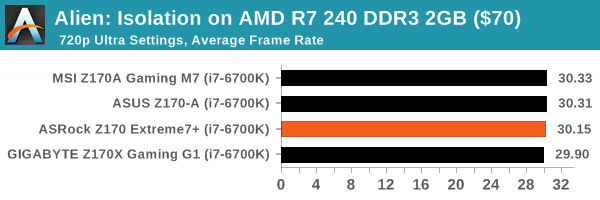

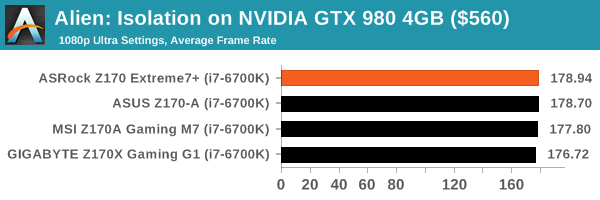
Total War: Attila
The Total War franchise moves on to Attila, another The Creative Assembly development, and is a stand-alone strategy title set in 395AD where the main story line lets the gamer take control of the leader of the Huns in order to conquer parts of the world. Graphically the game can render hundreds/thousands of units on screen at once, all with their individual actions and can put some of the big cards to task.
For low end graphics, we test at 720p with performance settings, recording the average frame rate. With mid and high range graphics, we test at 1080p with the quality setting. In both circumstances, unlimited video memory is enabled and the in-game scripted benchmark is used.
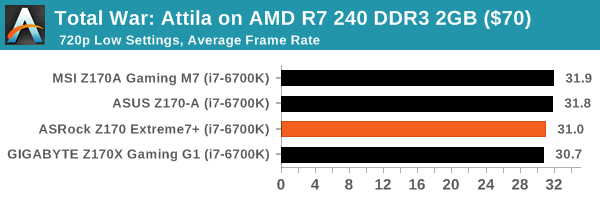

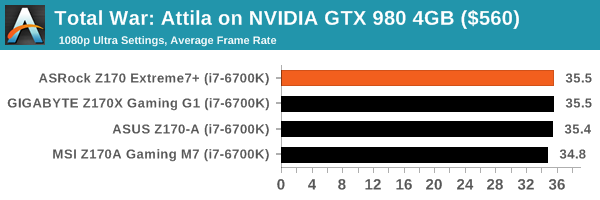
Grand Theft Auto V
The highly anticipated iteration of the Grand Theft Auto franchise finally hit the shelves on April 14th 2015, with both AMD and NVIDIA in tow to help optimize the title. GTA doesn’t provide graphical presets, but opens up the options to users and extends the boundaries by pushing even the hardest systems to the limit using Rockstar’s Advanced Game Engine. Whether the user is flying high in the mountains with long draw distances or dealing with assorted trash in the city, when cranked up to maximum it creates stunning visuals but hard work for both the CPU and the GPU.
For our test we have scripted a version of the in-game benchmark, relying only on the final part which combines a flight scene along with an in-city drive-by followed by a tanker explosion. For low end systems we test at 720p on the lowest settings, whereas mid and high end graphics play at 1080p with very high settings across the board. We record both the average frame rate and the percentage of frames under 60 FPS (16.6ms).
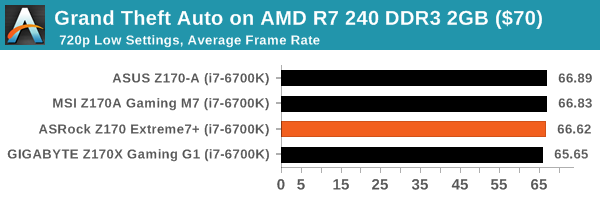
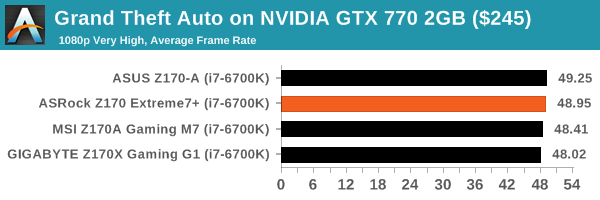
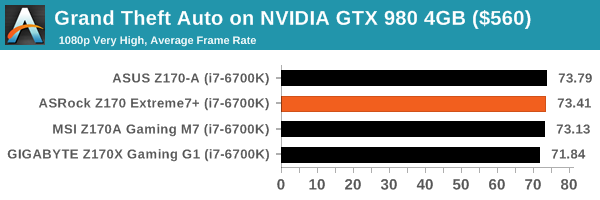
GRID: Autosport
No graphics tests are complete without some input from Codemasters and the EGO engine, which means for this round of testing we point towards GRID: Autosport, the next iteration in the GRID and racing genre. As with our previous racing testing, each update to the engine aims to add in effects, reflections, detail and realism, with Codemasters making ‘authenticity’ a main focal point for this version.
GRID’s benchmark mode is very flexible, and as a result we created a test race using a shortened version of the Red Bull Ring with twelve cars doing two laps. The car is focus starts last and is quite fast, but usually finishes second or third. For low end graphics we test at 1080p medium settings, whereas mid and high end graphics get the full 1080p maximum. Both the average and minimum frame rates are recorded.

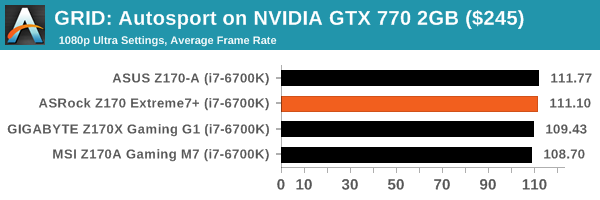
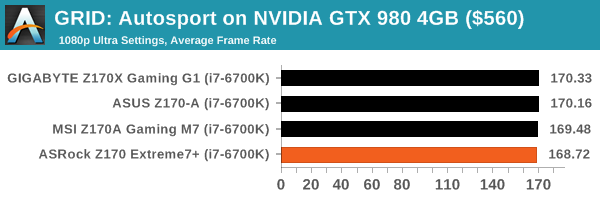
Middle-Earth: Shadows of Mordor
The final title in our testing is another battle of system performance with the open world action-adventure title, Shadows of Mordor. Produced by Monolith using the LithTech Jupiter EX engine and numerous detail add-ons, SoM goes for detail and complexity to a large extent, despite having to be cut down from the original plans. The main story itself was written by the same writer as Red Dead Redemption, and it received Zero Punctuation’s Game of The Year in 2014.
For testing purposes, SoM gives a dynamic screen resolution setting, allowing us to render at high resolutions that are then scaled down to the monitor. As a result, we get several tests using the in-game benchmark. For low end graphics we examine at 720p with low settings, whereas mid and high end graphics get 1080p Ultra. The top graphics test is also redone at 3840x2160, also with Ultra settings, and we also test two cards at 4K where possible.
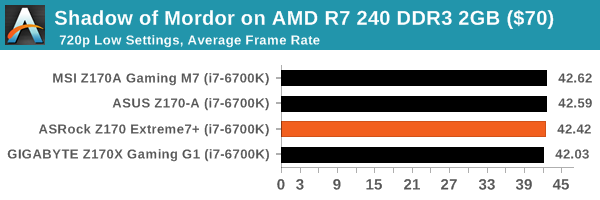
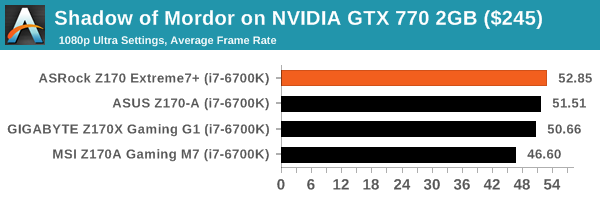
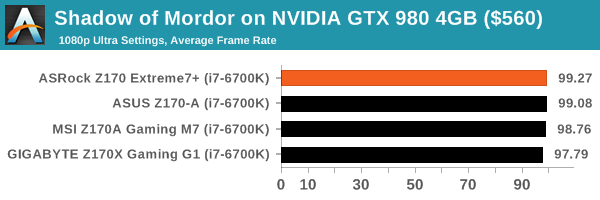
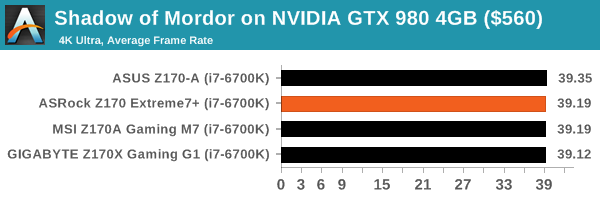















63 Comments
View All Comments
phorgan1 - Tuesday, December 22, 2015 - link
And it is 3.93 GB/s for 4 lanes of DMI 3.0nunya112 - Friday, November 27, 2015 - link
no. they will have their own. if there is no video card installed or if they only set the video card to 4Xthat would then dedicate all the lanes
4 will be in the DMI links, then depending if they have video card or not there will be 12 lanes free. meaning it would go full speed at 4X EACH = 12 lanes then the 4 lanes for the video card. or even none if using onboard
phoenix_rizzen - Sunday, November 29, 2015 - link
The video card slots get their lanes direct from the CPU.The M.2 slots get their lanes from the PCH, along with the x1 and x4 slots.
Separate lanes; not shared.
You can run SLI video setup using 16 lanes from the CPU, and still use 12 lanes for M.2.
extide - Monday, November 30, 2015 - link
BUT evilspoons/eddieobscurant are correct. The DMI link is EQUIVALENT to a PCIe 3.0 x4 link. Regardless of the video card setup, the 3 M.2 ports are sharing essentially the B/W of a single PCIe 3.0 x4 link.WITH THAT BEING SAID, this is still my #1 Z170 mobo. The feature combo is PERFECT. DO WANT
phoenix_rizzen - Monday, November 30, 2015 - link
Only if the storage controller is on the CPU, no? The DMI link is between the CPU and the PCH, correct? And the storage controller won't be sending all storage traffic through to the CPU (this isn't IDE), so that shouldn't be a bottleneck.extide - Thursday, December 3, 2015 - link
Where else is the data going to go? I mean if you are copying from one drive to another that are both hanging off the PCH ... I am not sure if it needs to go through the CPU or if it has something like DMA.Ian Cutress - Friday, November 27, 2015 - link
Something seems to have gone awry with our content engine. It should be fixed now.bug77 - Friday, November 27, 2015 - link
One of these babies should be delivered to my door tomorrow. Needless to say, I can't wait.Idrathernotsay - Friday, November 27, 2015 - link
Would it be possible to see a review of one of the lower-end z170 motherboards, even a quick test? I realize that they don't provide much in the way of interesting or remarkable features, but I'd be really interested in seeing what, if anything, you actually lose with a mobo under $100 in performance if you don't care enough about the "crazy" stuff to fork over twice or three times as much cash.Impulses - Friday, November 27, 2015 - link
Didn't they review the ASUS Z170-A? It's a little over your budget but it's one of the better "cover all bases" budget options (2 3.0 headers, Type C in back, M.2, etc). I think when you start going closer to $100 than $150 you do sacrifice a lot more than it's worth, starting with build quality.